You are probably in the movies and entertainment sector. And you need to stay ahead with the latest trends to keep yourself updated and your audience engaged.
And you know that QR Codes can potentially help you do it. Over the last decade, there has been an increase in smartphone penetration and access to high-speed internet.
These factors have made QR Codes popular. Hence, they are now being used across various industries for many diverse use cases.
Some of these include payments, promotions, education, and inventory tracking.
Similarly, QR Codes can be used to facilitate many operations in the movies and entertainment sector too. In this article, we will see seven ways how QR Codes can help the movies and entertainment industry.
A. How to use QR Codes in movies and entertainment industry
1. To ensure hassle-free check-in to theatres
This is one of the most common use cases of QR Codes in movies and entertainment. You would’ve seen them on the movie tickets already.
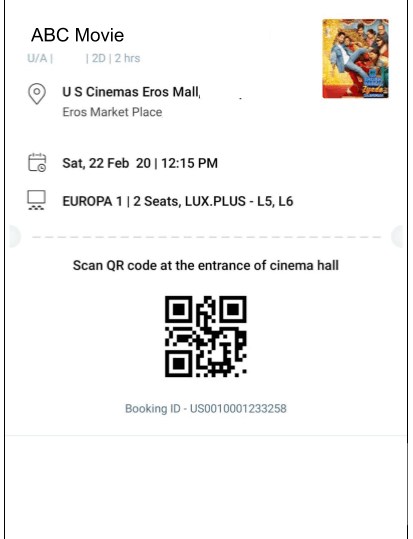
Once you book a ticket online, you can show its soft copy at the check-in. The person authorizing entries scans the QR Code on your ticket. And gets to know if it is a valid entry or not.
Since scanning a QR Code takes 2-3 seconds, the process becomes faster and smoother. It does two things. First, it saves people from waiting in long queues.
And second, it helps theatre authorities to validate entries securely without installing any cost intensive set-up. A smartphone is all they need to scan the QR Code.
BookMyShow, an online movie booking service, does the same. It helps customers book their movie tickets online. And adds a QR Code to the soft copies of these tickets.
This QR Code is scanned at the entry gate of the theatre and entry is granted.
2. To create a buzz about your upcoming movie
To create a buzz, a trailer is released before the movie. It tells the audience what the movie is about, what’s the plot, and what’s its cast. The audience can watch this trailer to decide if they want to watch the movie or not.
But releasing the trailer is not enough. You actually have to promote it well. Since when the trailer reaches out to a large audience, only then you can expect good response for the actual movie.
While you promote it online, you’d also want to do it offline. Why? Because digital promotions are readily actionable and don’t need end-users to put much effort.
But the problem is—you see many ads online every day. How many of them do you actually pay attention to? Not many, right?
On the other hand, offline promotions have a longer attention span. You do not receive many flyers and magazines every day, right?
But offline media is not actionable. Say if you add the link to the trailer on flyers, people will have to put both effort and time typing the link to watch it online.
So the best way is—to create a combination of the two (online and offline media). And QR Codes make an excellent tool to do that.
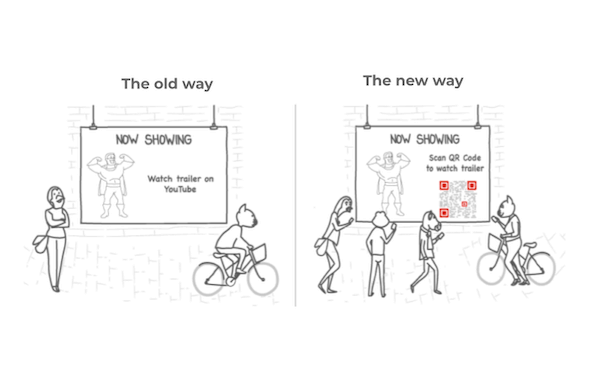
You can create a Video QR Code and add it to the flyers. Your audience can then scan it to view the trailer easily. Or you can also create a Website URL QR Code using the video link.
3. To get your audience to visit your website
Getting people to visit your website is a task. Say you want them to do it and display the link to your website on the movie screen.
How many people do you think will take the action? To be honest, not many.
The reason is—they’ll have to pull out their smartphones to tediously type the link and finally see your website. Since it needs effort, not many people bother doing it.
A QR Code here helps you make this process easier. We call it—a Website URL QR Code. When scanned, it helps the end-users to visit the encoded website without typing anything.
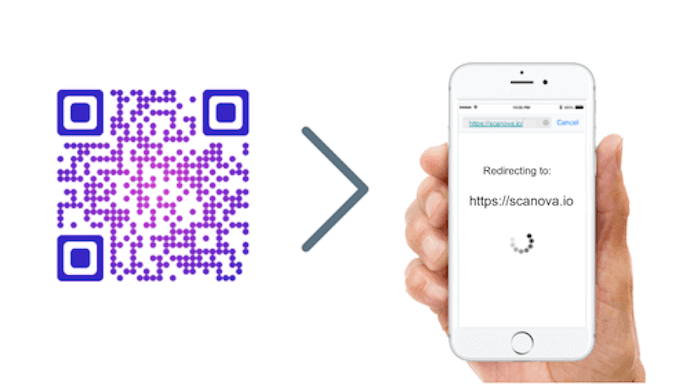
They simply need to scan the QR Code. That’s it. And you know—the easier the process, the better is the response rate.
And people are doing it already. In Shaun the Sheep movie (2015), the audience saw a QR Code hidden in the movie. On scanning it, it took the viewers to Shaun the Sheep’s website.
4. To promote your mobile application
Have you developed a mobile application (just like BookMyShow)? If it’s a yes, you’d want people to download it on their mobiles. But it’s easy said than done.
Just like visiting a website URL, installing an application needs effort. And an App Store QR Code helps you minimize this effort on the user’s end.
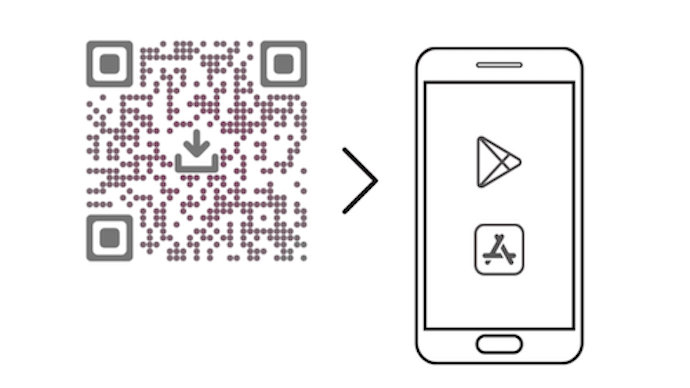
Like the name implies, an App Store QR Code stores the link to an app. And you don’t need to create separate QR Codes for all devices with different operating systems. A single QR Code is sufficient.
It redirects you to Google Play Store or App Store depending on the scanning device’s OS. Simple, right?
Also, an App Store QR Code is dynamic in nature. Hence, you can monitor its scanning activity. Not sure what a dynamic QR Code is? We’ll discuss it in detail later in the article.
The Redbox have used QR Codes for this purpose already. They placed App Store QR Codes on the vending machines. People could scan this QR Code to download their (Redbox’s) application on their phones.
5. To offer discount coupons to your audience
Offers and discounts are a great way to attract the audience in most sectors. To offer discounts you often give away promo codes. The audience can use these codes while booking the ticket to avail the offer.
To do this, you can use QR Codes. These QR Codes are also called Coupon QR Codes.
When you scan a Coupon QR Code, it shows you the promo code, a description, and an option to apply it.
This makes it easier for you to share coupons. And just like any other QR Code, it makes taking action easier for your audience.
Warner Bros Entertainment Inc., a multinational entertainment company, has used QR Codes for this purpose already.
6. To get reviews and ratings for the movie
Customer ratings and reviews are important for any business. They help you know what your audience expects and how has your performance been.
And they help your potential customers decide on whether they’d use your services (or watch the movie) or not.
But since submitting an online review is a tedious task, many people don’t bother doing it. So many businesses now use QR Codes to get customer reviews.
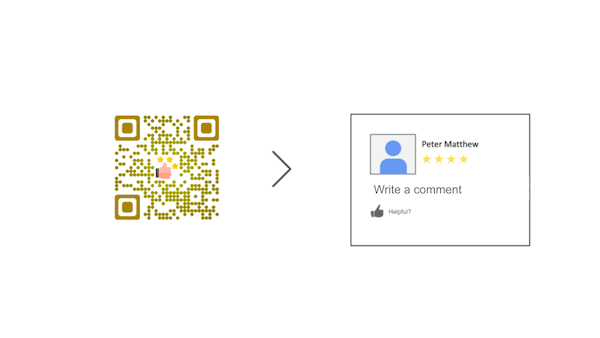
This QR Code, when scanned, takes the end-users directly to the reviews page. Hence, they can give their ratings and comments right away. No need for them to spend time finding the review page online.
And since the process becomes easier, the number of responses received also increases.
7. To build a community on social media
Do you have active social media accounts where you post updates regularly? Great! Then you’d want people to follow you on these platforms.
Social media is one of the best ways to build a community and keep people updated on the upcoming movies.
And to get people to follow you on social media easily, you can use a Social Media QR Code.
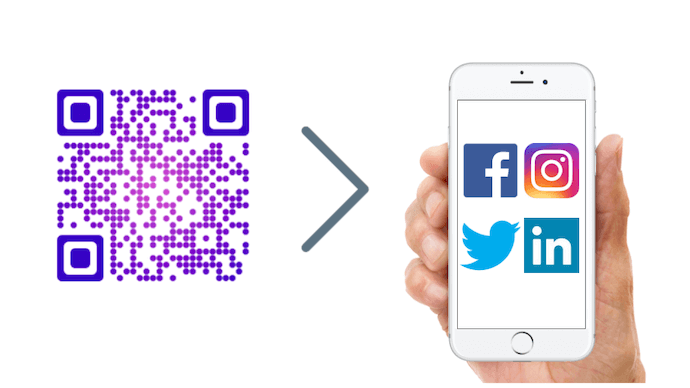
As people scan it with their smartphones, they see a landing page with links to all your social media accounts. They can then decide their favorite platform to follow you online.
You can display this QR Code on movie screens and even on print media creatives. For example—movie tickets and posters.
These are seven ways movies and entertainment industry can use QR Codes for various use cases.
B. Advantages of using QR Codes in the movies and TV industry
1. Cost-effective marketing
QR Codes are a low-cost way do promotions and attract quality traffic. They minimize the need for expensive ways to add interactivity to your print media assets and make them interesting for the end users.
For example, a television show may create a limited-edition goods line. By including QR Codes on promotional posters, fans can easily scan it to go to the online store to explore/buy products.
2. Increased accessibility
QR Codes allow visitors to easily access extra information/assets by scanning them. This improves the user experience, making them more likely to interact with the material.
For example, at a film festival, a QR Code on the program guide would help provide viewers rapid access to trailers of the films being screened. This simplifies their decision-making process, making the festival experience convenient and pleasurable.
3. Interactive and immersive experiences
QR Codes can act as doorways to immersive activities like augmented reality (AR) features, games, and virtual tours. This improves the viewing experience for the audience to engage them in new ways.
For example, a fantasy television series’ episodes contain QR Codes that allow viewers to access augmented reality events.
Fans may scan the codes to view 3D versions of the show’s monsters or navigate virtual set pieces, making the experience immersive.
4. Valuable data collection
By tracking QR Code scans, you can gain significant insights into audience behavior, preferences, and engagement levels. This data can be utilized to refine future content and marketing initiatives.
For example, a movie studio uses QR Codes on digital posters to take spectators to a survey. Here, they may rate their favorite moments and characters.
The data would help the studio understand audience preferences for better marketing efforts and content creation.
5. Direct fan interaction
QR Codes allow for direct connection with fans, such as through social network links, contests, or special offers. This fosters a loyal community and improves the fan experience.
For example, a popular TV drama’s season finale episode contains a QR Code. This connects viewers to a social media contest to submit fan art. The finest contributions are featured in the show’s next promotional campaign, creating a strong sense of community and participation among spectators.
What our customers think about us:
C. Real-life examples of QRs in the movies and TV industry
1. “Black Mirror: Bandersnatch” (2018)
In this movie, a mysterious QR Code appeared which directed viewers to a website, where they could play a game called “Nohzdyve.” It was a great immersive experience that helped viewers go beyond the screen of their favorite movie.
2. “John Wick: Chapter 2” (2017)
To promote the movie, the producers of John Wick used QR Codes in their marketing materials. When users scanned the QR, it took them to exclusive content such as interviews, sneak peeks, and behind-the-scenes.
3. “Ready Player One” (2018)
The promotional materials of the film used augmented reality experiences. The virtual interaction by the fans helped create buzz for the movie and helped market it better.
4. Season 4 of “Stranger Things” (2022)
Netflix used QRs to promote the latest season of Stranger Things. When users scanned these QRs, they were able to access unreleased materials, such as AR experiences, cast interviews, and unreleased trailers, which added to the understanding of the show’s universe.
5. “The Batman” (2022)
Warner Bros. included QRs in digital advertisements and posters for “The Batman” in 2022. Fans were able to access a wealth of extra content through scanning these QRs, such as character biographies and teasers.
6. “The Jurassic” franchise
The series gave fans a more engaging method to interact with the brand by using QRs on posters and souvenirs to unlock a range of unique features. This included augmented reality dinosaur encounters, behind-the-scenes footage, and games.
7. “Avengers: Endgame” (2019)
To promote their hugely successful film “Avengers: Endgame” (2019), Marvel Studios hid QRs in promotional materials. By scanning these codes, fans were able to access behind-the-scenes videos and other special content.
Brands that trust us:
D. Best practices for QR Codes
1. Always add a CTA
While adding a QR Codes, you must also add an instruction or call-to-action statement with it.
It could be—Scan here to watch the trailer now. Or Scan here to grab the offer.
A simple push like this helps the audience know what action they need to take. And what to expect after scanning the QR Code.
2. Design your QR Code
If your use case is promotional, you must consider designing your QR Codes. This is because black-and-white QR Codes are dull and boring.
But QR Codes designed by adding color and logo act as a point-of-engagement. Hence, they attract as many scans as possible.
3. Track your campaign performance
If you are a marketer, you know that it’s important to keep an eye on your campaigns. It helps you know how you are doing and channelize your effort accordingly.
And dynamic QR Codes help you do it. Dynamic QR Codes are both editable and trackable. You can edit their content even after you’ve created them. Further, you can also track their scanning activity. For example—number of scans, date and time of scans, location of scans, etc.
4. Test scan the QR Code
Before you go ahead with printing or displaying the QR Code for your audience, always test scan it.
It will ensure that you don’t print a non-functional QR Code.
That’s it. That’s all you need to know about QR Codes in the movies and entertainment industry.


E. FAQs: QR Codes in movies and entertainment
1. What is the application of QR Codes in entertainment and film?
Promotional materials, goods, and even the content of TV shows and movies frequently incorporate QR Codes. They can point visitors to behind-the-scenes videos, trailers, interactive features, augmented reality (AR) content, and more unique content.
2. What are the advantages of selling entertainment with QR Codes?
With the help of QR Codes, viewers may easily access extra content and get more involved with a film or television program. In addition to serving as a smooth transition between offline and online marketing initiatives, they can boost fan connection and deliver insightful statistics on viewer engagement.
3. Is it possible to use QR Codes whilst watching TV or a movie?
It is possible to incorporate QR Codes straight into a film or television program. They could, for example, show up on screen as a plot device, directing viewers to websites or other content that enhances the viewing experience.
4. How do QR Codes improve the experience for viewers?
Immersion experiences can be obtained through QR Codes, which grant access to relevant digital content. These could be augmented reality (AR) experiences, games, exclusive interviews, backstories of the characters, or anything from the extended world that improves the viewer’s comprehension and pleasure of the narrative.
5. Does the use of QR Codes in entertainment raise privacy issues?
Similar to any other digital technology, QR Codes may cause privacy issues if they gather data without the user’s permission. To protect users’ privacy, responsible use calls for open communication about the data that is gathered and its intended purpose.
6. How do marketers and filmmakers monitor the success of QR Codes?
Filmmakers and marketers can monitor the frequency of code scans by utilizing distinct QR Codes for various campaigns or platforms. This information sheds light on the success of different marketing techniques as well as audience involvement.
7. What is an example of a QR Code marketing that has been effective in the entertainment sector?
The use of QR Codes in the “Stranger Things” Season 4 promotional campaign is one noteworthy instance. To gain access to exclusive content, including interactive experiences and trailers, fans had to scan codes, which increased anticipation and involvement for the premiere of the show.
8. Is it possible to personalize QR Codes in entertainment content?
It is possible to modify QR Codes to match the branding and style of the entertainment content. To improve their appeal and cohesiveness with the overall design, they can include images, colors, and logos.
9. Do movies and TV shows that use QR Codes have any difficulties using them?
Making sure viewers have adequate time and clarity to scan the codes is one challenge. Furthermore, audience familiarity with QR Code technology may vary, which may restrict interaction. Overcoming these obstacles requires careful positioning and clear directions.
10. How are movie and TV program merchandising items incorporating QR Codes?
Movie posters, DVD covers, toys, T-shirts, and even food packaging related to a film or television show can all be found with QR Codes written on them. Access to exclusive digital content, discounts, and special features may be obtained by scanning these codes.
Summing Up
We’ve seen that QR Codes are more than simply a new technology; they’re an effective tool for bridging the digital and physical worlds.
In the film and entertainment industries, they provide viewers with an entry point to unique content, more in-depth interaction, and off-screen interactive activities.
The way that viewers engage with their favorite stories is being redefined by QR Codes, which may be anything from a hidden code that opens up behind-the-scenes video to an augmented reality experience that brings characters to life.
Thus, don’t be afraid to scan a QR Code the next time you see one in a movie poster or at a performance—you might just discover a whole new world of enjoyment!
These little squares of data will only get more fascinating and interconnected as the industry innovates further, improving our viewing experiences in ways we can’t even begin to fathom. The future of entertainment is just a smartphone scan away, so keep an eye out and be prepared!


